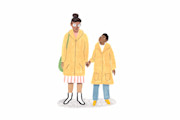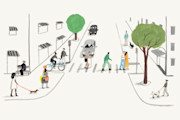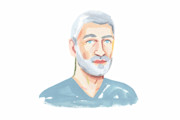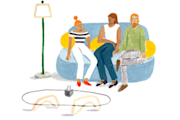Could you have symptoms of adult autism?
If you're wondering whether you're living with undiagnosed autism spectrum disorder (ASD), you're not alone.
Americans' curiosity in and Google searches for adult autism and the related term "neurodivergent" spiked up significantly in mid-2020 and have steadily increased since, according to Google Trends.
Read on for more information on autism spectrum disorder, neurodiversity, the symptoms of autism in adults, and how to get a diagnosis and treatment for ASD.

What is autism spectrum disorder (ASD)?
According to the American Psychological Association (APA), autism spectrum disorder is "a neurodevelopmental disorder characterized by difficulties with social communication and social interaction and restricted and repetitive behaviors, interests, and activities."
Autism develops in early childhood, and it's a spectrum disorder so symptoms and their severity vary among individuals—meaning autism can look different from person to person.
There appears to be a diagnostic gender bias—consequently, girls who meet criteria for autism are at disproportionate risk of not receiving a diagnosis.
Primary care physicians, psychologists, and psychiatrists can evaluate symptoms and provide an autism spectrum disorder diagnosis.
Many licensed mental health professionals specialize in therapy for adults with autism.

How many American adults live with autism?
In 2020 the Centers for Disease Control and Prevention (CDC) estimated 5.5 million American adults (just over 2% of U.S. residents over 18) are living with autism spectrum disorder (ASD).
Celebrities and prominent public figures who have opened up about being diagnosed with ASD include:
Actor and artist Anthony Hopkins
American scientist, animal behaviorist, and author Temple Grandin, Ph.D
Tesla and Space X founder Elon Musk
Swedish climate justice activist Greta Thunberg
Actor and comedian Dan Akroyd
Actress and environmental activist Daryl Hannah
New York state assembly representative Yuh-Line Niou
Scottish singer and Britain's Got Talent contestant Susan Boyle
Men are four times more likely to be diagnosed with autism than women, according to Autism Speaks.
However, as the authors of a 2017 meta-analysis conclude, the true male-to-female ratio is not four-to-one, rather, it is closer to three-to-one.
The review's authors call attention to gender bias in diagnosis from pediatricians and mental health professionals.
"There appears to be a diagnostic gender bias," they write, "meaning that girls who meet criteria for ASD are at disproportionate risk of not receiving a clinical diagnosis."

Is neurodivergent the same as autism?
According to a 2015 article titled "The Myth of the Normal Brain: Embracing Neurodiversity" by Dr. Thomas Armstrong, Ph.D., neurodiversity is a term originally coined in the late 1990s by Australian sociologist, Judy Singer and New York journalist Harvey Blume, who wrote a 1998 article on neurodiversity in The Atlantic.
Armstrong, author of the 2011 book The Power of Neurodiversity: Unleashing the Advantages of Your Differently Wired Brain, explains in his article that the word neurodiversity was initially created "to articulate the needs of people with autism who did not want to be defined by a disability label, but wished to be seen instead as neurologically different."
Today autism spectrum disorder, ADHD, and dyslexia are all considered neurodiverse conditions.
As Nicole Baumer, MD, and Julia Frueh, MD, point out in their 2021 article for Harvard Medical School’s Harvard Health Publishing, while the concept of neurodiversity began within the autism rights community, it has now grown beyond to also encompass other neurological conditions such as ADHD.
Today autism spectrum disorder, dyslexia, and attention deficit hyperactivity disorder (ADHD) are all considered neurodiverse conditions.
Neurodiversity is the idea that “people experience and interact with the world around them in many different ways; there is no one ‘right’ way of thinking, learning, and behaving,” according to Baumer and Frueh.
In his 2021 article for the American Psychiatric Association (APA) Psychiatric News, Stanford University Department of Psychiatry and Behavioral Sciences assistant professor and director of Stanford’s Neurodiversity Project, Dr. Lawrence Fung, M.D., Ph.D., writes, “Neurodiversity is about acknowledging that the brain of each person is developed uniquely—resulting in differences in abilities and behavioral traits among all people.”
Can you have ASD and ADHD?
Yes, you can.
And, since the APA's Diagnostic and Statistical Manual, Fifth Edition (DSM-5) was released in 2013, making it possible for the first time for children and adults to be diagnosed with both autism and ADHD, many people now have a dual diagnosis.
Both ASD and ADHD are neurodevelopmental disorders, meaning brain development has been affected in some way.
As many as 50%-70% of individuals with autism spectrum disorder (ASD) also have attention deficit hyperactivity disorder (ADHD).
According to Children and Adults with Attention Deficit Hyperactivity Disorder (CHADD), both conditions affect the central nervous system, which is responsible for movement, language, memory, and social and focusing skills.
A 2021 meta-analysis of 56 studies found that 50%-70% of individuals with autism spectrum disorder (ASD) also present with comorbid attention deficit hyperactivity disorder (ADHD).
What are some symptoms of autism in adults?
If the symptoms listed below sound familiar to you, consider speaking with a medical professional and/or find a mental health therapist who specializes in adults with ASD.
1. Difficulty maintaining eye contact
People living with autism may avoid eye contact because it can cause them stress or pain.
This can go beyond avoiding a stranger’s gaze.
Adults on the autism spectrum consistently struggle to make or maintain eye contact even with people they are comfortable around, including family, friends, and coworkers.
The lack of eye contact doesn’t mean there’s a lack of interest.
Autistic adults may experience high levels of stimulation in their brain when making eye contact with others, so avoiding eye contact is a way of avoiding anxiety or physical discomfort.
2. Difficulty picking up on small social cues
Deciphering nonverbal, subtle social cues can be hard for adults with autism spectrum disorder, so they may feel lost in conversation.
Adults on the autism spectrum typically may interpret nonverbal communication—including facial expressions, eye-rolling, and hand gestures—differently than neurotypical people.
3. Struggling to empathize
Adults living with autism spectrum disorder are often mistakenly seen as apathetic, because ASD may interfere with their ability to accurately interpret social cues that enable a neurotypical person to more easily infer what others are thinking or feeling.
For individuals with autism spectrum disorder, providing an “appropriate” emotional response or looking at things from someone else’s perspective can be challenging.
People with autism tend to listen and use words literally as opposed to using inference and accounting for the entire context of a conversation.
4. Struggling to hold back and forth conversations
In addition to struggling with nonverbal communication, the “art of conversation” is often a difficulty for adults on the autism spectrum.
This can present as someone dominating a conversation—rather than participating in a more typical back-and-forth.
5. Repetitive behaviors or "stimming"
Engaging in certain physical motions or making certain sounds repetitively can relieve stress or anxiety for an adult living with autism or ADHD.
This is self-stimulating behavior, also called “stimming,” and people with ADHD and throughout the neurotypical spectrum do it as well.
The difference is that autistic adults may have more visible/obvious ways of stimming: Instead of drumming their fingers on a table, a person with autism may rock back and forth or flap their hands.

6. Strict adherence to a routine (and outbursts when routines are disrupted)
Autism spectrum disorder can manifest in a strict dependence on daily routines.
Individuals living with autism may become angry or upset when any detail of their day—whether it be a misplaced item or canceled activity—is changed.
Stringent routines have some overlap with Obsessive-Compulsive Disorder (OCD) tendencies, though ASD and OCD are two separate things.
Research is still ongoing on the overlap between the two disorders, but it’s thought that 17% of individuals living with ASD also have OCD.
A significant difference between ASD and OCD tendencies is that people suffering from OCD have a need to do a specific task, whereas people with autism spectrum disorder are more soothed by repetition than the specific task.
7. Laser focus on details and facts
Some people living with autism spectrum disorder have trouble organizing details and inferring the big picture from facts or smaller pieces of information.
It may be easier for them to pay attention to every small detail individually, and consequently autistic adults may have a hard time categorizing and prioritizing information or applying information from one setting to another.
For example, people living with ASD may remember and understand the facts of an article they read, but not be able to identify the main idea or theme of the article if it's not explicitly stated.
8. Sensitivity (or lack thereof) to sounds, textures, light
People living with autism spectrum disorder sometimes process sensory stimulation (e.g. sounds, colors, textures) with different intensity than neurotypical people.
This means they may have an extreme reaction—or no reaction at all—to sensory stimulants like loud sounds, bright lights, or pain.

What to do if you suspect you're living with adult autism
The symptoms of ASD listed above are not an exhaustive list, and an autism spectrum disorder diagnosis must be made by a licensed medical professional, such as a psychologist or psychiatrist.
For some adults, an ASD diagnosis can provide comfort, relief, and a clearer path forward. You may also want to speak with a practitioner who specializes in autism spectrum disorder.

While autism spectrum disorder is a life-long condition, some therapeutic treatments—including applied behavioral analysis, cognitive behavioral therapy (CBT), and certain medications—can help manage symptoms.
Find a licensed practitioner who treats autism spectrum disorder as well as therapists experienced with cognitive behavioral therapy (CBT).
READ NEXT: Surprising Symptoms of ADHD in Adults
Need to find a therapist near you who specializes in clients with autism spectrum disorder? Check out Monarch by SimplePractice to find licensed therapists with availability and online booking.
Autism and Autism Spectrum Disorders. (2014). Autism and Autism Spectrum Disorders. Retrieved from https://www.apa.org website: https://www.apa.org/topics/autism-spectrum-disorder
Autistic Self Advocacy Network. (2021). About Autism. Retrieved January 4, 2021, from Autistic Self Advocacy Network website: https://autisticadvocacy.org/about-asan/about-autism/
CDC. (2020, June 29). Diagnostic Criteria. Retrieved from: https://www.cdc.gov/ncbddd/autism/hcp-dsm.html
Massachusetts General Hospital. "Why do those with autism avoid eye contact? Imaging studies reveal overactivation of subcortical brain structures in response to direct gaze." (2017) ScienceDaily. www.sciencedaily.com/releases/2017/06/170615213252.htm
Why Do Autistics Have Issues with Social Skills? (2017, August 8). Retrieved from: https://www.appliedbehavioranalysisedu.org/why-do-autistics-have-issues-with-social-skills/
Marchetti A, Miraglia L, Di Dio C. Toward a socio-material approach to cognitive empathy in autistic spectrum disorder. Front Psychol. 2020;10:2965. doi:10.3389/fpsyg.2019.02965
Ryan, G., Brady, S., Holloway, J., & Lydon, H. (2018). Increasing appropriate conversation skills using a behavioral skills training package for adults with intellectual disability and autism spectrum disorder. Journal of Intellectual Disabilities. https://doi.org/10.1177/1744629517750744
van Steensel, F. J. A., Bögels, S. M., & Perrin, S. (2011). Anxiety Disorders in Children and Adolescents with Autistic Spectrum Disorders: A Meta-Analysis. Clinical Child and Family Psychology Review, 14(3), 302–317. https://doi.org/10.1007/s10567-011-0097-0
Autism and Autism Spectrum Disorders. (2014). Autism and Autism Spectrum Disorders. Retrieved from https://www.apa.org/topics/autism/index.html
Asperger Profiles: The Big Picture-Challenges – The Asperger / Autism Network (AANE). (2016, July 22). Retrieved from: https://www.aane.org/asperger-profile-big-picture-challenges/
Yuhas,Spectrum, D. (2019, February 28). Untangling the Ties between Autism and Obsessive-Compulsive Disorder. Retrieved from Scientific American website:https://www.scientificamerican.com/article/untangling-the-ties-between-autism-and-obsessive-compulsive-disorder1/







